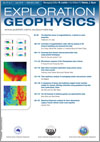
Exploration Geophysics
Volume 47 Number 2 2016
EG14093The distortion tensor of magnetotellurics: a tutorial on some properties
The magnetotelluric distortion tensor is analysed by two methods of linear algebra: eigenvalue analysis and singular value decomposition. Mohr diagrams display the results, and emphasise important characteristics of the distortion. Examples compare traditional Groom-Bailey decomposition with singular value decomposition.
EG14093 Abstract | EG14093 Full Text | EG14093PDF (745 KB) Open Access Article
EG14044Correction of magnetotelluric static shift by analysis of 3D forward modelling and measured test data
A new zero-cost method of correcting static shift in magnetotelluric data is proposed based on 3D forward modelling and field tests. The method has been verified using synthetic and real data.
EG13077Denoising time-domain induced polarisation data using wavelet techniques
We have conducted the first application of wavelet-based denoising techniques for processing raw TDIP data. Our investigation included laboratory and field measurements to better understand the advantages and limitations of these techniques. It was found that distortions arising from conventional filtering can be significantly avoided with wavelet-based methods.
EG15019Microtremor response of the Cheongcheon dam in Korea
Microtremors were analysed using the H/H and H/V methods to estimate site effects of the Cheongcheon earthen dam in Korea. The peak near 3 Hz may correspond to depth to the bedrock, whereas the other peaks at higher frequencies may reflect the geometrical effect of the dam or overtone responses.
EG15020High lateral resolution exploration using surface waves from noise records
We use seismic interferometry to process ambient noise recorded in measurement lines. The Rayleigh wave component of the Green’s Functions is obtained with a high S/N ratio. Using CMPCC analysis, we can identify lateral variations of phase velocity inside the seismic line with higher resolution compared to conventional analysis.
This paper describes a cepstrum analysis using window functions to determine the interval between P-waves in similar, overlapping microseismic events. The window functions isolate the two P-waves and suppress the second S-wave. Applications of the method to both synthetic and field data show that it can identify the P-wave interval.
EG15033 Abstract | EG15033 Full Text | EG15033PDF (5.2 MB) Open Access Article
EG14114A comparison of binary and multiclass support vector machine models for volcanic lithology estimation using geophysical log data from Liaohe Basin, China
This paper describes the use of binary and multiclass support vector machine models with geophysical log data to estimate the volcanic lithology of the Liaohe Basin in China. A comparison between predicted data and actual data from four wells indicates that binary and multiclass support vector machine models are effective methods for classifying volcanic lithology.
EG14110The 3D inversion of airborne gamma-ray spectrometric data
A new method is presented for the inversion of airborne gamma-ray spectrometric line data to a regular grid of radioelement concentration estimates on the ground. The method incorporates the height of the aircraft and the topography. It eliminates terrain effects and improves the interpolation between flight lines.
EG15022Numerical dispersion analysis for three-dimensional Laplace-Fourier-domain scalar wave equation
Based on the phase velocity and attenuation propagation velocity, a method for performing numerical dispersion analysis of three-dimensional Laplace-Fourier-domain scalar wave equation is presented. This method is applied to a 27-point average-derivative optimal scheme and a 27-point finite-element scheme.

